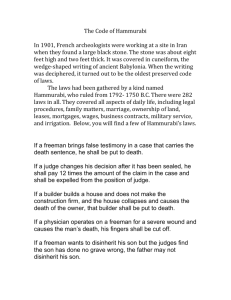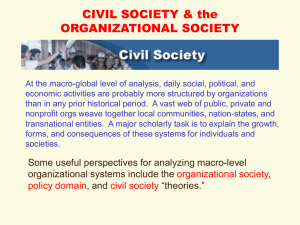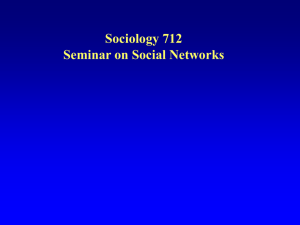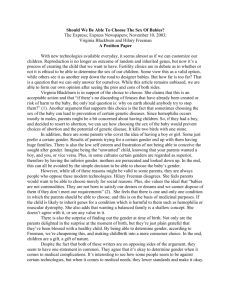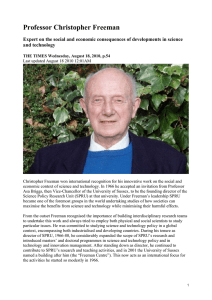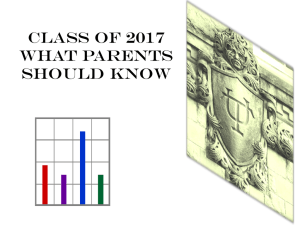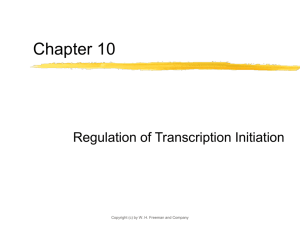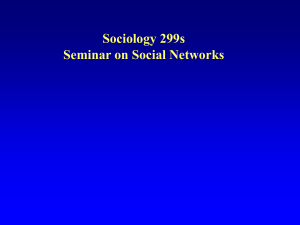SOC 8311 Basic Social Statistics
advertisement
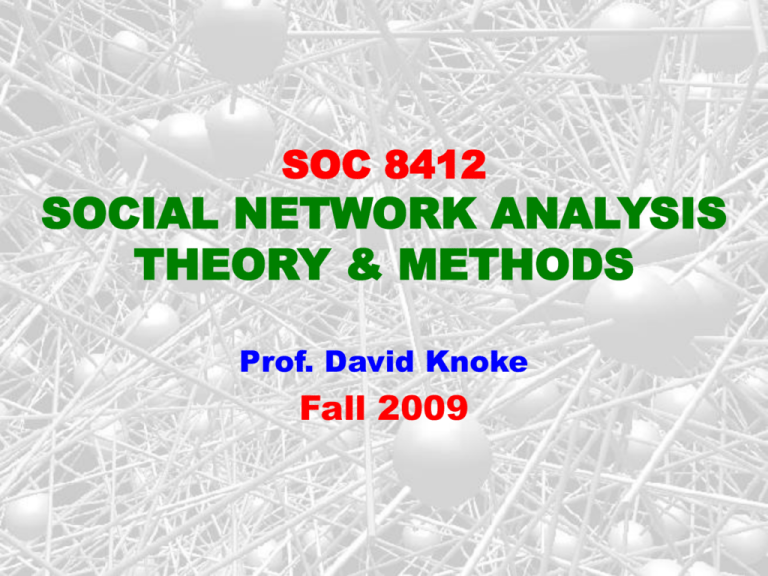
SOC 8412 SOCIAL NETWORK ANALYSIS THEORY & METHODS Prof. David Knoke Fall 2009 SOCIAL NETWORK ANALYSIS An interdisciplinary perspective emphasizes structural relationships as key explanatory concepts & principles: • Structural properties of social formations are contexts that shape the perceptions, beliefs, attitudes, and actions of individuals and collectivities • Social influence and collective action may be facilitated and/or constrained by direct and indirect exchanges (transactions) among social actors possessing differential resources (e.g., information, money, power, grace) • Embeddedness (location of actors within actual situational contexts) must be analyzed as dynamic processes Contrast these structural-relational approaches to substantialist explanations premised on “thing-concepts” as basic unit of analysis: actor essence, self-action, normative conformity, rational choice, variable-centric, and social identity approaches (Emirbayer 1997) Theories & Methods Network research involves the continual interplay of both theoretical and methodological tools to investigate a wide range of substantive questions THEORY: Analytic concepts, principles, interrelated propositions that explain empirical observations ► Relational vs substantive perspectives (Emirbayer 1997) ► Social capital theories (Coleman 1990; Lin 2001) ► Structural holes (Burt 1997) ► Organizational field-nets (Kenis & Knoke 2002) METHODS: Measures, data, computer techniques to test theoretical propositions ► Matrix algebraic methods (Wasserman & Faust 1994) ► Visualization programs (Freeman 2000) Multi-level & Interdisciplinary Network applications appear in diverse substantive fields of most social sciences – anthropology, management, public health, sociology, economics (but political science?) Studies span micro-, meso-, & macro-levels of analysis: personal social & health support systems children’s play groups, high school cliques neighboring behavior, community participation work teams, voluntary associations, social movements military combat platoons, terrorist cells corporate strategic alliances, board interlocks international relations: trade, aid, war & peace Growth of Social Networks in Social Sciences Five-year totals for 14 literature indexes Keyword search for "social" + "network*" 10,000 TOTAL 8,000 Abstracts 6,000 4,000 Titles 2,000 0 1965 1970 1975 1980 1985 1990 1995 2000 2005 2010 (Projected) YEAR Network Analysis Origins Although antecedents lie in 1920s (Freeman 1996), Jacob L. Moreno pioneered social network analysis for his “psychodrama” therapy. He used sociomatrices and handdrawn sociograms to display children’s likes and dislikes of classmates as directed graphs (digraphs). Visualization has been a key component of social network analyses from the beginning, proliferating into today’s dazzling computer-based multidimensional displays (Freeman 2001) Moreno’s sociomatrix … … displayed as a sociogram What structure is evident in his arrangement of squares and circles? Colorado Springs Sexual Contact Network SOURCE: James Moody. http://www.soc.sbs.ohio-state.edu/jwm/ The 9-11 Hijacker Network SOURCE: Valdis Krebs http://www.orgnet.com/ OECD Trade Flows 1981-1992 SOURCE: Lothar Krempel http://www.mpi-fg-koeln.mpg.de/~lk/netvis.html Org-chart shows how authority ties should look… SOURCE: Brandes, Raab and Wagner (2001) <http://www.inf.uni-konstanz.de/~brandes/publications/brw-envsd-01.pdf> … but the digraph of actual advice-seeking … … can be restructured to reveal the “real” hierarchy! Anthropologists In 1950s, social anthropologists at Manchester University extended sociometric techniques to studies of families, kinship, and friendship networks in urban settings of both advanced and developing societies ► Elizabeth Bott, Max Gluckman, J. Clyde Mitchell, S.F. Nadel John Barnes credited with applying analytic rigor to concept of “social network”. He saw “the whole of social life” as “a set of points some of which are joined by lines” to form a “total network” of relations. The informal sphere of interpersonal relations was a “partial network” within this total network (Barnes 1954:43). A detailed history of network analysis appears in John Scott. 1991. Social Network Analysis: A Handbook. London: Sage. <http://www.analytictech.com/mb119/tableof.htm> Conflict in an African Factory SOURCE: Kapferer, Bruce. 1969. “Norms and the Manipulation of Relationships in a Work Context” in Social Networks in Urban Situations: Analyses of Personal Relationships in Central African Towns, edited by J. Clyde Mitchell. Digraphs of Donald & Abraham SOURCE: Stephen J. Appold, University of Singapore http://courses.nus.edu.sg/course/socsja/SC2202/Labor/Employee3a.html Sociologists In 1970s, sociologists at Harvard, Chicago, Toronto & elsewhere applied finite mathematical, graph theoretic, clustering, and spatial modeling methods to uncover small group structures and community networks ► Conflict among novice monks in a monastery (White et al 1976) ► Cleavages in urban political networks (Laumann & Pappi 1976) ► Community lost, preserved, or extended? (Wellman 1979) By 1990s, network analysis had proliferated to business management, public administration, law, and related fields ► Strategic alliance networks (Gulati 1995) ► Self-managed work teams (Barker 1999) Strategic alliances in the 1998 core GIS SOURCE: David Knoke. 2001. Changing Networks. Boulder, CO: Westview. INSNA Institutionalization achieved with the 1978 founding of the International Network for Social Network Analysis and journal Social Networks <http://www.insna.org> Sunbelt Social Network Conferences are held annually in North America or Europe (2009 San Diego, CA; 2010 Trento, Italy) EGOS (European Group on Org Studies) annual colloquium has a Standing Group on Organizational Network Research (2009 Barcelona; 2010 Lisbon) References Barker, James R. 1999. The Discipline of Teamwork: Participation and Concertive Control. Thousand Oaks, CA: Sage Publications. Barnes, John. 1954. “Class and Committees in a Norwegian Island Parish.” Human Relations 7:39-58. Bott, Elizabeth. 1957. Family and Social Network: Roles, Norms, and External Relationships in Ordinary Urban Families. London: Tavistock. Freeman, Linton C. 1996. “Some Antecedents of Social Network Analysis.” Connections 19: 39-42. Freeman, Linton C. 2000. “Visualizing Social Networks.” Journal of Social Structure <http://zeeb.library.cmu.edu:7850/JoSS/article.html> (July 24, 2002). Gulati, Ranjay. 1995. “Social Structure and Alliance Formation Patterns: A Longitudinal Analysis.” Administrative Science Quarterly 40:619-652. Laumann, Edward O. and Franz Urban Pappi. 1976. Networks of Collective Action: A Perspective on Community Influence Systems. New York: Academic Press. Mitchell, J. Clyde. 1969. Social Networks in Urban Situations: Analyses of Personal Relationships in Central African Towns. Manchester: Manchester University Press. Moreno, J. L. 1934. Who Shall Survive? Washington: Nervous & Mental Disease Publishing Co. White, Harrison C., Scott A. Boorman and Ronald L. Breiger. 1976. “Social Structure from Multiple Networks, I: Blockmodels of Roles and Positions.” American Journal of Sociology 81:730-780. Wellman, Barry. 1979. “The Community Question: The Intimate Networks of East Yorkers.” American Journal of Sociology 84:1201-1231.

